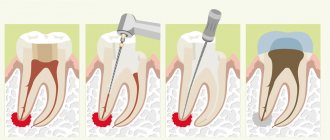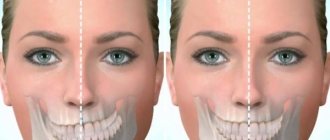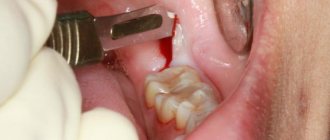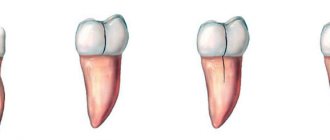An inflammatory formation affecting the upper part of the tooth root is called granuloma. It is formed during the development of periodontitis. Tooth granuloma is tightly attached to the root, being the initial stage of a granular cyst (cystogranuloma), from which it differs, in fact, only in its slightly smaller size. If the formation is ignored and not treated, it will begin to increase.
Tooth granuloma: symptoms of the disease
Only a doctor can make a diagnosis based on an x-ray, where a darkening will be visible in the root area. Any darkening in the image is a sign of the presence of a cavity, but if a granuloma occurs, it means that periodontitis, which is chronic in nature, begins to develop.
For a long time, the tooth may not bother a person at all. Sometimes pain may occur when biting or when eating hot food: these are the first signs of the development of chronic periodontitis. An exacerbation of the disease is observed during periods of weakening of the body's immunity: then the pain intensifies significantly, which is especially noticeable when biting. During such periods, as a rule, the gums become swollen, and in the area of inflammation it becomes painful to touch.
What is the risk of developing the disease?
If treatment for tooth root granuloma is not started in a timely manner, then first you risk losing your tooth. But there are other negative consequences:
- dental cyst - the formation of a capsule filled with dead cells and bacteria;
- periostitis or flux - inflammation of the periosteum with the formation of a purulent sac;
- fistula - a hole or canal in the gum;
- abscess - inflammation as a result of rupture of a purulent formation in soft tissues.
Purulent inflammation is a dangerous condition in which self-medication can lead to even greater problems - meningitis, sepsis and others. When the first signs appear, you should immediately consult a doctor. Diagnosis and removal of dental granuloma requires high professionalism of the doctor. The specialists of the Comfort Dentistry clinic will be happy to help you with this.
Why does granuloma appear on the root of a tooth?
At the tops of the roots, such formations can appear for several reasons:
- Poorly performed treatment of pulpitis. If caries is started, the affected cavity gradually becomes quite deep. When microorganisms enter the pulp, its inflammation begins, accompanied by acute pain, which may stop over time, indicating the death of the nerve.
But the development of the disease does not end: bacteria through the root canals extend beyond the boundaries of the affected tooth, as a result of which a focus of inflammation appears near the upper parts of the roots, called periodontitis. The further course of the disease can occur according to several scenarios, one of which is the formation of granuloma.
It is necessary to understand that a tooth with a granuloma does not necessarily have to be affected by caries, since the root can become inflamed near a tooth that has already been treated. If the doctor has not completely removed the tissues affected by caries by placing a filling on top of them, then there is a high risk of developing pulpitis with the subsequent formation of granuloma.
- Filling of root canals performed with violations. A granuloma that appears on the root of a tooth whose canals were filled some time ago indicates the unsatisfactory quality of the procedure performed. Due to inattention, haste or inexperience, the doctor could not fill the canals to the very top. Dentists often refuse to admit their own mistake, because in this case they will have to treat the tooth for free. Such unfortunate specialists can evade until the last minute, pretending that they do not understand the causes of pain, recommending taking a course of antibiotics.
Granuloma and cyst: what do they have in common?
To summarize, all granulomas are divided into simple and complex. The first type is characterized by a slight compaction of granulation tissue without the release of purulent exudate. Developed forms have a pronounced focus of inflammation and large sizes (up to 10 millimeters in diameter). Some experts do not share the concepts of cyst and granuloma. This needs to be sorted out. A classic granuloma does not have clear boundaries and shape, while a cyst is a capsule with purulent fluid, much larger in size, usually with less pronounced symptoms. On the other hand, a cyst is a developed form of granuloma, i.e., in fact, its more complex type.
Diagnosis of granuloma on the tooth root
At the early stage of development of the disease, it will not be possible to notice any visual changes. The first signs of pathology become noticeable as the size of the infected area and the amount of pus increase.
To treat the disease with therapeutic methods, it is necessary to examine the affected area in detail: a complete picture of the granuloma must be obtained, which will allow one to detect key signs of the disease that differ from other diseases.
When suppuration occurs, the gums become very red and swollen, and pain appears, which can radiate to the head area in general and the ear in particular. This is the first symptom that should make you wary.
The following methods can be used to make an accurate diagnosis:
- use of classical x-rays;
- the use of radiovisiography or, in simpler terms, computer x-ray.
In the picture, the affected area looks like a dark spot with a clear border in the upper part of the tooth. The size of the spot indicates the following:
- 5-8 mm – the probability of having a dental granuloma is high;
- more than 8 mm – formation in the form of a cyst.
In rare cases, a large granuloma, up to 1.2 cm in size, may occur. Therefore, X-rays may not be enough for diagnosis: it is recommended to perform a biopsy of tissue cells from the area affected by the disease.
In most cases, granuloma is discovered during treatment of other dental diseases: the doctor may pay attention to increased swelling and swelling of the gums. In addition, the bone tissue near the top of the tooth may also bulge.
An increased risk of developing granuloma is observed in patients with crowns and pulpless teeth. Such people are advised to undergo regular examinations in order to promptly identify any changes affecting the gums and teeth.
Treatment at the Family Dentist clinic
We have a good reputation in Minsk, consultations are conducted by dental therapists with 16 years of experience , specializing in the treatment of dental canals. They trust us; more than 80% of patients brought family members and friends to the clinic. Every second patient has been with us for more than 6 years. We do radiovisiography on site in the office, working with four hands together with an assistant to reduce the time of unpleasant manipulations. The effectiveness of dental granuloma treatment is ensured by premium class equipment. Even with serious damage to the crown and root, we strive to preserve the dental unit.
Tooth granuloma: treatment
Usually treatment is only therapeutic in nature, but its strategy may vary depending on whether the canals have been filled before.
- If the canals have not been filled, the tissues affected by caries are drilled out, and the old filling is removed. This is required to carry out high-quality mechanical treatment of the canals, which are expanded and treated with antiseptic agents. If the granuloma is small (formations up to 3 mm are considered such), then the canal is sealed immediately. If the size of the granuloma exceeds 3 mm, the treatment period increases, since it is necessary to put a medicine into the canal, which includes potassium hydroxide - this substance leads to a decrease in the granuloma or even to its complete disappearance. A temporary filling is placed for the period the medication is placed (approximately 2-3 weeks). Then a repeat x-ray is taken, which should clearly show a significant reduction in the inflammatory formation. If the dynamics are obvious, the canals are sealed and a permanent filling is placed.
- If the canals have been filled, then the first stage of treatment is their unsealing. The further sequence of actions is similar to that described in the previous paragraph. The only thing is that if there is a crown on the tooth, it will have to be removed, and after the treatment is completed, it will have to be made and placed again. Some patients do not want to spend money on re-installing a crown: the solution is to perform a root resection operation, when the upper part with the granuloma attached to it is cut off through a small incision in the gum.
Depulpation: one of the main methods of treating pulpitis
To treat pulpitis, different methods are used, but most often tooth depulpation is performed. This procedure involves opening the tooth, removing the nerve bundle, and treating the canals. The canal cavities are not only thoroughly and efficiently washed with an antiseptic solution, but also filled with filling material. Popularly, this procedure is called a simple phrase - removal of the dental nerve. Pulp removal is a procedure that doctors try to resort to when it is not possible to carry out conservative treatment of pulpitis. Removing a bundle of vessels and capillaries makes the tooth fragile and vulnerable to external factors, and can cause a change in the shade of the enamel coating. But in order to be able to carry out conservative treatment of pulpitis, you need to contact a doctor as early as possible, and not wait until incessant pain appears.
Granuloma between tooth roots: treatment with antibiotics
The number of people putting off visiting a doctor until the last minute is large. There are many reasons for this: fear of pain (although modern means of anesthesia make it possible for the patient to feel nothing at all during treatment procedures), lack of free time, and reluctance to part with money. But all these reasons and excuses come to naught when the pain becomes unbearable, becoming chronic. As practice shows, as soon as a person does not sleep for a couple of nights, the issue of the need to visit the dentist is resolved by itself.
However, many people try to cure granuloma on their own using strong antibiotics, which is basically impossible. Antibiotics may be prescribed to relieve inflammation and stop the formation of pus, but nothing more. But the action of antibiotics may not affect pathogenic microorganisms located in the root canals, and it is the infection in their unsealed areas that is the only reason for the formation of granulomas.
If a patient comes to the doctor with a suspicion of granuloma, and the doctor, driven by some of his own considerations, does nothing, recommending taking antibiotics, it is better not to delay time, but to immediately contact another dentist. Some doctors simply do not like to re-treat someone’s poorly treated teeth, since repeating the same operations takes much more time, while others, if the patient comes back again, do not want to admit that they made a mistake, which for them is tantamount to realizing their own lack of competence.
Forms of tooth pulpitis
The classification of dental pulpitis into different forms was introduced in the early 90s of the last century; it is actively used by modern dentists and distinguishes acute and chronic pulpitis. Usually, patients experience acute pulpitis, but if the symptoms of the disease can be relieved with painkillers and it is not treated by a dentist, the acute form can become chronic, revealing its presence with rare attacks of severe pain in the tooth. It is relatively rare that chronic pulpitis initially develops, which is characterized by an almost complete absence of pain. The main forms are separately classified into subtypes, the diagnosis of which must be extremely accurate. The effectiveness of pulpitis treatment as a whole will depend on the correctness of the diagnosis.
Tooth granuloma: surgical treatment
If therapeutic treatment does not help, then surgery comes into play: the operation is performed in the presence of a destructive process affecting the gums, and anesthesia (both general and local) is used to carry it out.
There are several surgical treatment options.
Root resection
Elimination of granuloma occurs in several stages:
- a passage to the top of the tooth opens by peeling off the gum shell;
- the root canals are cleaned and subsequently filled with medicinal substances;
- excision of the granuloma is carried out;
- the area is filled with synthetic fabrics;
- the tooth is filled.
On average, the operation takes about an hour.
Hemisection
If a tooth has many roots, then this procedure is prescribed (if there are complications that prevent the root from being saved).
The treatment procedure includes:
- removal of roots under the crown;
- filling the empty space between the roots with a special dental product;
- installation of a crown;
- monitoring the condition of the tooth using x-rays.
The method is simple, while the functionality of the tooth is preserved. If necessary, some time after the procedure, the patient can resort to prosthetics, provided that the root system remains healthy.
Cystotomy
The method is used when removal of large granulomas is required.
To implement it:
- a channel is created between the affected area and the oral cavity, through which pus absorbed by tampons is removed;
- after cleaning, the cavity is treated with antibacterial agents;
- sutures are placed;
- the cavity, free from suppuration, is filled with bone cells.
Depulping a tooth with pulpitis
Depulpation is carried out in three stages:
- The dentist removes damaged layers of enamel and dentin;
- Having gained access to the pulp chamber, the doctor removes the pulp bundle;
- The tooth canals are washed with an antiseptic and sealed;
- The crown part of the tooth is restored with a composite filling.
All therapeutic measures must be carried out by an experienced and competent specialist, carried out carefully and painstakingly, otherwise a relapse of the disease or the development of complications of pulpitis is possible, the treatment of which sometimes involves tooth extraction (if the inflammatory process affects a significant part of the root system of the unit).
How long will it take to treat pulpitis? The answer to this question depends on the form of the disease and the complexity of the case. Several visits to the clinic will definitely have to be made if we are talking about treating a multi-rooted tooth with pulpitis. So that you understand why the process of treating pulpitis in this case will be long and why it is better not to let the tooth develop pulpitis at all, we will describe in detail all stages of the treatment process.
Measures to prevent granuloma after an extracted tooth
Preventive measures are aimed at preventing the development of the disease. They include:
- high-quality cleaning of teeth and gums on a daily basis;
- timely treatment of bleeding gums;
- regular visits to the dentist at least once a year (it is better to do this twice);
- replacing toothbrushes (old brushes accumulate bacteria that can provoke the development of the disease);
- contacting the dentist at the slightest pain associated with the gums or teeth;
- treatment of caries, periodontitis and pulpitis - quite often these diseases are the catalyst for the development of granuloma;
- the use of medicated toothpastes and herbal decoctions for rinsing;
- eating foods rich in calcium and other trace elements.
Our doctors are always ready to help and cure granuloma.
| Pankratieva Alesya Georgievna. Practicing dentist of the first qualification category. More than 15 years in the profession. Founder of the Family Dentist clinic, Member of the Belarusian Dental Association. View profile | Bobkova Irina Leonidovna. Practicing dentist of the highest qualification category. More than 20 years in the profession. Assistant professor. Co-author of a patent for a method of treating periodontitis. View profile |
Feedback from our patient:
Thank you very much for your attentive attitude towards patients. Quality services. I have been discussing at the Family Dentist for a long time and the doctors always have a good mood and a smile on their face. I will recommend your dentistry to my friends and acquaintances.
With respect, Gameza N.A.
| Do not leave the source of infection untreated - sign up for the Family Dentist clinic. The sooner you start treatment, the cheaper and easier it will be. | Call to make an appointment +375 29 604-61-61 |
Complications after granuloma at the site of an extracted tooth
Lack of timely treatment and hope that the disease will go away on its own is fraught with serious consequences. Among the most common complications it is worth highlighting:
- development of periodontitis and further formation of a fistula;
- the occurrence of alveolitis is a consequence of the presence of an inflammatory process;
- formation of purulent flux;
- suppuration of the perimaxillary tissue;
- entry of pathogenic bacteria into the lymph nodes, from where they penetrate the cardiac system and internal organs (kidneys, liver and brain);
- development of facial asymmetry;
- the emergence of new foci of infection;
- infection of the body due to the penetration of pathogenic microorganisms into the blood vessels.
Timely removal of granuloma is a guarantee to avoid unpleasant health consequences.
Causes of pulpitis
Pulpitis in children and adults occurs for a number of reasons. Among them, the following stand out:
- Advanced caries. If caries treatment is not started on time, it will begin to affect the deep layers of dental tissue until it reaches the pulp. Once inside, microorganisms will cause inflammation.
- Improper treatment of caries. In this case, pulpitis occurs almost immediately after caries treatment has been carried out, and there may be several reasons for this: The dentist did not remove all carious tissues, and they continue to destroy the tooth;
- During the treatment, the pulp received a thermal burn due to insufficient cooling;
- Before starting the filling, the dentist dried the bottom of the tooth cavity with an air jet;
Indications
Elimination of pathology using a biological method is recommended in the following cases:
- Fibrous pulpitis without pain.
- Deep caries.
- Acute pulpitis with discharge of serous pus.
- Hyperemia of the pulp due to the spread of caries.
- Opening the pulp during the treatment of a carious cavity.
Surgical intervention is permissible only if there are no results with conservative treatment. Tooth extraction is carried out when complications arise after surgery and in the absence of positive dynamics.
Contraindications
Contraindications to conservative treatment:
- Exacerbation of the disease.
- Location of carious tissues in the cervical area.
- Purulent-necrotic form of pathology.
- Intolerance to medications and anesthesia.
Why is granuloma dangerous?
Granulation after tooth extraction, trauma, dental surgery is a natural phenomenon necessary for healing. This is a type of connective tissue that normally fills a wound and allows it to heal.
The process becomes pathological and leads to the formation of a granuloma if an infection gets into the wound. In this case, the granulation lesion begins to grow rapidly, replacing other tissues.
Even if the neoplasm does not manifest itself in any way and does not cause discomfort, granulation of the tooth and gums can lead to the development of serious complications:
- The growth of granuloma leads to the destruction of tissue at the root apex.
- The inflammatory process affects healthy tissue, which can result in the formation of an abscess, phlegmon, and osteomyelitis.
- There is a risk of developing fistulas, the channel of which can extend to the skin of the face.
- Since granuloma is asymptomatic for a long time, the infection can spread very widely, causing sinusitis, pyelonephritis, myocarditis, etc.
It is very important to diagnose and treat granuloma promptly. This will help avoid many serious health problems, and not only dental ones.
Prevention
To avoid the development of cystogranuloma and its possible consequences, it is necessary to follow some preventive measures:
- examined twice a year to check for pathologies in the oral cavity and teeth and have them eliminated in a timely manner.
- Carefully monitor oral hygiene
- Change toothbrushes often .
- healthy .
It must be remembered that self-medication using traditional medicine recipes without a doctor’s recommendation can lead to serious consequences.











